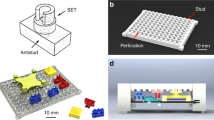Abstract
An intelligent digital microfluidic processor for biomedical detection is presented. This potential architecture solves lots of traditional development bottlenecks to implement the easy-to-control, easy-to-monitor, system automation and high accuracy for bioassay detection purposes. The proposed processor integrates the functions of microfluidic actuation, droplet location readback and high sensitivity measurement window to demonstrate a novel prototype for personalized medicine. Furthermore, the droplet location map and reaction behaviors are visible on a 2-dimentional (2D) graphical user-interface due to the micro electrode dot array (MEDA) architecture and capacitive sensing technology, and hence system automation is achievable. Fabricated in standard 0.35 μm CMOS process, this work integrates 900 microelectrodes with measurement window in 3.2 mm2, where the high sensitivity capacitive readout circuit occupies only 0.048 mm2. Measurement results show that microdroplet actuation and 2D location map are activated under 1KHz. In addition, the function of digital signal extraction, processing, as well as statistical analysis can be operated under 1 MHz respectively.
















Similar content being viewed by others
References
Lin L. et al., Integrated optical sensor in digital microfluidics platform,” IEEE Sensors, pp.628-635, May 2008.
Vijay S. et al., An integrated digital microfluidics lab-on-a-chip for clinical diagnostics on human physiological fluids, Lab Chip, pp.310-315, Apr. 2004.
Gary Wang et al., Digital microfluidic operations on micro-electrode dot array (MEDA) architecture, IET Nanobiotechnology, pp.152-160, May 2011.
R. B. Fair, Digital microfluidics: is a true lab-on-a-chip possible? Microfluid Nanofluid, pp. 245–281, Mar. 2007.
Stefan H. et al., Microfluidic platforms for lab-on-a-chip applications, Lab Chip, pp. 1094–1110, Sep. 2007.
Kelvin Yi-Tse Lai et. al., A digital microfluidics processor for biomedical applications, In Proc. IEEE SiPS’13, pp. 54–58.
Sha Xia, et al., A capacitance-to-digital converter for displacement sensing with 17b resolution and 20μs conversion time, In Proc. IEEE ISSCC, pp. 198–200, 2012.
Chun-Chieh Wang, et al., Integrated Accelerometer with capacitance to digital interface circuit design based on monolithic 0.18 μm CMOS MEMS technology, in Proc. IEEE Sensors, pp. 1–4, 2012.
Kota Tanaka, et al., A 0.026 mm2 Capacitance-to-digital converter for biotelemetry applications using a charge redistribution technique, In Proc. IEEE ASSCC, pp. 244–247, 2007.
P. Bruschi, et al., A low-power capacitance to pulse width converter for MEMS interfacing, In Proc. IEEE ESSCIRC, pp. 446–449, 2008.
S. A. Jawed, et al., A 828 μW 1.8 V 80dB dynamic range readout interface for a MEMS capacitive microphone, In Proc. IEEE ESSCIRC, pp. 442–445, 2008.
Zhichao Tan, et al., A 1.8 V 11μW CMOS smart humidity sensor for RFID sensing applications, In Proc. IEEE ASSCC, pp. 105–108, 2011.
Shin, D.-Y., et al. (Feb. 2011). A Delta-Sigma Interface Circuit for Capacitive Sensors with an Automatically Calibrated Zero Point. IEEE TCASII, 58(2), 90–94.
Hans Danneels, et al., A fully-digital, 0.3 V, 270nW capacitive sensor interface without external references, In Proc. IEEE ESSCIRC, pp. 287–290, 2011.
Zhichao Tan, et al., An energy-efficient 15-bit capacitive sensor interface, In Proc. IEEE E SSCIRC, pp. 283–286, 2011.
Zhichao Tan, et al., A 1.2V 8.3nJ energy-efficient cmos humidity sensor for RFID applications, In Proc. IEEE VLSIC, pp. 24–25, 2012.
Acknowledgments
Work supported by 5Y50B program of MOE, Taiwan. The authors would like to thank Dr. Gary Wang, Ms. Julia Lu and SI2 members for many fruitful discussions and CIC for many technical supports.
Author information
Authors and Affiliations
Corresponding author
Electronic supplementary material
Below is the link to the electronic supplementary material.
(WMV 14402 kb)
Rights and permissions
About this article
Cite this article
Lai, K.YT., Yang, YT. & Lee, CY. An Intelligent Digital Microfluidic Processor for Biomedical Detection. J Sign Process Syst 78, 85–93 (2015). https://doi.org/10.1007/s11265-014-0939-3
Received:
Accepted:
Published:
Issue Date:
DOI: https://doi.org/10.1007/s11265-014-0939-3




